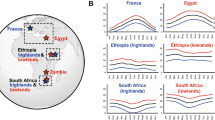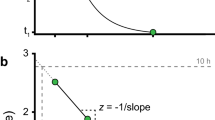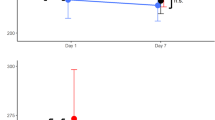Abstract
INSECTS, like other cold-blooded animals, are active over a range of temperature, limited below by the chill coma point, and above by the heat coma point (closely related to the thermal death point, that is, the upper lethal temperature, for they cannot recover from long periods of heat coma). On the whole, the heat coma point is higher for insects from warm regions, and the chill coma point is lower in those from cool regions.
This is a preview of subscription content, access via your institution
Access options
Subscribe to this journal
Receive 51 print issues and online access
$199.00 per year
only $3.90 per issue
Buy this article
- Purchase on Springer Link
- Instant access to full article PDF
Prices may be subject to local taxes which are calculated during checkout
Similar content being viewed by others
References
Mellanby, K., Proc. Roy. Soc., B, 127, 473 (1939).
Mellanby, K., J. Animal Ecol., 9, 296 (1940).
Mellanby, K., Parasitol., 30, 392 (1938).
Wigglesworth, V. B., J. Exp. Biol., 29, 620 (1952).
Author information
Authors and Affiliations
Rights and permissions
About this article
Cite this article
MELLANBY, K. Acclimatization and the Thermal Death Point in Insects. Nature 173, 582–583 (1954). https://doi.org/10.1038/173582b0
Issue Date:
DOI: https://doi.org/10.1038/173582b0
This article is cited by
-
A unifying model to estimate thermal tolerance limits in ectotherms across static, dynamic and fluctuating exposures to thermal stress
Scientific Reports (2021)
-
10.1007/BF00344522
CrossRef Listing of Deleted DOIs (2011)
-
10.1007/BF00364568
CrossRef Listing of Deleted DOIs (2011)
-
10.1007/BF00291786
CrossRef Listing of Deleted DOIs (2011)
-
10.1007/BF00291787
CrossRef Listing of Deleted DOIs (2011)
Comments
By submitting a comment you agree to abide by our Terms and Community Guidelines. If you find something abusive or that does not comply with our terms or guidelines please flag it as inappropriate.



